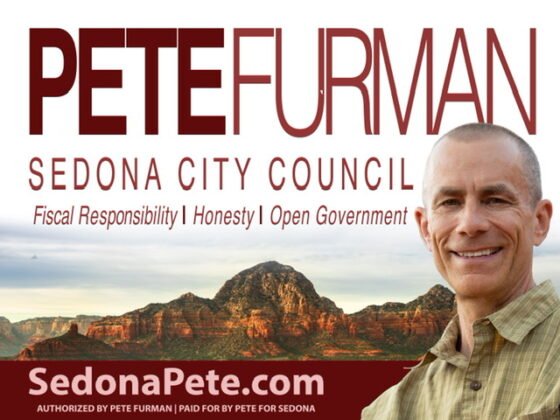Sedona Election News: The following is an interview with Sedona City Council candidate Pete Furman. All council candidates have been invited to answer specific questions in relation to their positions and candidacy.
- What office are you running for?
I’m a candidate for the Sedona City Council.
- Why are you running?
I’m running to improve the quality of life for Sedona residents, to protect our environment, and maintain local control of our budget process and rules.
Sedona is my home, I care about our future, and have the desire, experience, and energy to help manage its direction.
Learn more about me at SedonaPete.com.
- How long have you lived in Sedona?
I first visited Sedona in 1986, and moved here full-time in March of 2018 with my wife, Lisa Voss.
- When did you decide to get involved politically?
While this would be my first elected position, I’ve been involved in local government for 15 years, in multiple cities.
In Sedona, I became actively involved shortly after arriving in 2018.
- What do you believe are your qualifications for office?
I am a Sedona Planning and Zoning Commissioner and a member of the Sedona Police Pension Board (the PSPRS). I served on City Workgroups that considered the merits of Home Rule and reviewed the City Budget. Just prior to moving to Sedona I served eight years as Chief of Staff to the Mayor of San Jose, California.
Last year, I received the City of Sedona Commitment Award for “dedication and unparalleled expertise and for advancing the betterment of Sedona.”
Through experience, I’ve learned how to work with the public, elected officials, and city staff. I understand how local governments set policy and I enjoy the public process.
I began working as mechanical engineer in Phoenix in 1986. Later, I founded a high-tech manufacturing company. In 2007 I began my work as Chief of Staff. I am currently retired.
- What have you accomplished in serving the community?
As a Planning and Zoning Commissioner, I requested that staff broaden their outreach to local Native American and Hispanic communities for input to the Community Plan Update, and helped staff reach members of the Hispanic community to participate in local programs. I’ve encouraged the public to pay attention to, and comment on, planning and zoning matters. I have been supportive of workforce housing projects in Sedona.
PSPRS Board Members review policies and procedures to ensure that they are non-discriminatory and inclusive. I’ve been fair to applicants and taxpayers in deciding pension matters.
My goals as a member of the Home Rule and Budget Workgroups included making sure all facets of our community were represented, their needs and perspectives considered, and I emphasized honesty, fiscal responsibility, and open government.
- What do you think is better? Electing people who have served for years in office, committees, etc.? Or electing a candidate that may be politically inexperienced but brings new ideas to the table?
What’s best is a government that works for its residents. A mix of experience and fresh ideas is needed, and the best candidates bring both.
Leaders don’t have to bear the burden of idea generation alone. Many residents, organizational partners, and non-profits exist to help find creative solutions.
Public service looks easy, but it’s not. Governments use complex and unique accounting systems, have bureaucratic governance and decision processes, and their actions face intense public scrutiny. These elements often surprise and frustrate inexperienced elected officials.
- What are the main challenges you see Sedona facing and how would you address them? Please include the issue of homelessness and panhandling at shopping centers, etc.
Sedona’s biggest challenge is its declining full-time residential population. Our future as a residential community is at stake.
Sedona residents have seen a dramatic rise in short-term rentals (STRs), which led to a drop in long-term rentals, pushing workers out of town. Businesses are having difficulty hiring and retaining staff because of the cost and limited availability of housing. Traffic, noise, and overcrowding are problems. Resident focused services like healthcare and education have declined.
I will be laser-focused on improving quality of life. I’ll track our traffic, STR, and housing efforts and will ask for outcome-based measures to gauge progress. I support the Sedona In Motion (SIM) projects, will work to complete them, and will seek additional traffic improvements. I believe unregulated, commercially operated STRs are mini hotels using state-protected loopholes, and don’t belong in our neighborhoods. I’ll work to help change state legislation that prevents local control.
I believe workers, families, and retirees all enrich our community. I want more teachers, police officers, firefighters, nurses, city employees, artists, and hospitality and service workers living in Sedona. We can’t solve everyone’s needs for housing within city limits, but we’ll do what we can and work regionally to encourage more supply.
While homelessness and panhandling are problems, only aggressive panhandling, trespassing, and loitering can be prosecuted. Thankfully, several area non-profits are working to alleviate these issues. But Sedona cannot solve homelessness on its own. Solutions involve providing social services that are difficult to deliver effectively and are expensive. These efforts are best led by county governments via their health and welfare responsibilities and implemented regionally to be fiscally responsible to taxpayers.
- Are Short Term Rentals (Airbnb type rentals) beneficial or detrimental to the community? Should they be licensed, limited or eliminated? As a member of the city council how would you address the issue?
The original concept of a resident homeowner offering a spare bedroom to visitors, meeting interesting people, and making a little money was a fair concept. Trouble arose when out-of-town corporate entities opened mini hotels in our neighborhoods and caused a decline in our sense of community.
The State of Arizona severely restricts what cities can do to regulate STRs. Our efforts need to concentrate on electing state officials who understand our concerns and support local control.
Neighborhoods deserve protection. Given the extent of this problem, Council needs to empower and direct city staff to be maximally creative and push the legal limits.
- Would you rather have less Airbnb’s and more hotels? Or vice-versa?
I think we need fewer corporate-owned STRs in our neighborhoods and that our entire collection of resident and visitor housing need to be kept in balance with our infrastructure carrying capacity. The balance of hotels and STRs is a free-market question and best answered by supply and demand.
- Do you support the city’s current SIM (Sedona in Motion) initiatives and plans for infrastructure improvements? Why or why not?
Yes, I support the SIM initiatives. I wish we could execute them more quickly. But governmental process restraints and rising construction costs slow implementation. The SIM projects are designed to improve the carrying capacity of our infrastructure and they will relieve burdens we all face.
- What should the city do to address the issue of affordable housing, especially for people working in businesses in Sedona?
Cities thrive when people live, work, raise their families, participate in events, and contribute their talents locally.
Sedona has fewer housing options compared to other towns our size. We must encourage development of additional housing types with a range of affordability options. We can encourage parcel owners along our commercial corridors to redevelop and implement denser mixed-use commercial/retail/housing projects. Improving the permitting process can help reduce development costs and speed projects along.
Will we be able to meet everyone’s housing needs? No, but we must do what we can, and work across the Verde Valley to further increase housing options and availability. A robust transit system must also be built to encourage commuting and ease traffic congestion and pollution.
- What is the role of the Chamber of Commerce and Tourism Bureau in the community?
A Chamber of Commerce helps local businesses survive by helping them build skills, network together, and to efficiently market their products and services. A Tourism Bureau helps promote and manage tourism.
In Sedona, many residents believe promoting tourism isn’t necessary to attract visitors anymore. Social media, travel websites and magazines, and every photo ever taken of Sedona has revealed us to the world. We’ve been ‘discovered.’ Like many tourism-driven towns, we face problems with overtourism. Our City and Chamber must adapt and mitigate these new stresses.
There’s concern in our community about taxpayer funding for the Chamber of Commerce. Some call to defund the Chamber, while others rally to its defense. The city budget process is the proper venue for this discussion. Thoughtful, fact-based arguments are needed to help us avoid unintended outcomes like increased problems with over-tourism, unnecessarily expanded city government, or pitting residents against local businesses they support.
There are reasonable questions being asked about how and why taxpayer dollars are allocated and spent, and how efficient and effective the spending is. Clarity is good, our overwhelmed residents deserve it.
- Sedona’s economy is primarily based on tourism. How should it be managed to benefit both residents and visitors?
Sedona’s economy is tourism driven. And it’s been successful beyond our wildest dreams, and nightmares.
Moving forward, Sedona needs to measure tourism-generated revenues in detail, and to purposefully dedicate significant portions to mitigating tourism caused problems. Resident contributions must also be calculated and used for their needs and desires. Everything must be clearly communicated.
This all happens today through a long and tedious budget process that is difficult for residents to follow. I’ll seek process and communication improvements to better inform and involve residents. I’ll vote to improve residents’ quality of life, protect our environment, and maintain local control.
Tourists have always been drawn to Sedona. If we make the resident experience top-notch, our economy and our visitors will be well-served.
- What approach can the city take in mitigating the impact of ATV’s and OHV’s on city streets and forest roads?
The environmental destruction caused by irresponsible ATV/OHV operators west of our city brings tears to one’s eyes. So do the dust clouds. Many are concerned about health, livability, and safety for those who live in and visit these areas, and for the damage being done to our fragile desert environment which is difficult or impossible to heal. There’s also potential harm being done to cultural artifacts. In town, Sedona residents suffer from noise, traffic, and safety issues. Our Broken Arrow residents are particularly impacted by overuse problems.
After speaking with many affected residents and giving comment at the Council sessions, I believe controlling vehicle speed is important. Lower speed reduces noise, dust, and damage. It also increases safety and livability. However, reducing speed requires deliberate road design, education, and enforcement.
Other sensible ideas include limiting access to sensitive locations and requiring all ATV users to hire trained, responsible guides.
Public policy solutions require participation and collaboration from all stakeholders: residents, ATV owners, City of Sedona, Red Rock Ranger District, the Arizona Legislature, ATV businesses, State and Federal agencies, manufacturers, and others. I wish it were easier, but that’s how we govern. We listen, learn, collaborate, and come up with workable, effective, and affordable solutions.
In the meantime, our residents push for interim actions. State laws bind our hands, but not our minds. Let’s stay creative, positive, and reasonable. Awareness, education, and collaboration are key.
- Do you support the city’s Sustainable Tourism Plan? Why or why not?
Having sustainable tourism isn’t a luxury, it’s a necessity for Sedona. The Sustainable Tourism Plan was developed and led by our Chamber of Commerce and is a roadmap for intentionally achieving sustainability. I support the Plan.
Is the current Plan perfect? No, it’s aspirational and meant to be motivational. It needs to be a living document, updated regularly. Outcomes must be measurable. Greater emphasis must be placed on making and communicating progress, especially for the Resident Quality of Life Objectives.
- Do you support the city’s Climate Action Plan? Why or why not?
Climate change is real, and Sedona residents demanded and received a plan to tackle issues that can be addressed locally. It’s legitimate for government to advocate for and demonstrate good choices. I support the Plan.
Water issues such as flood protection, water supply and quality, and conservation and reuse will get my immediate attention. As will fire prevention, risk reduction and preparedness, and evacuation planning.
Like the tourism plan, Sedona’s Climate Plan needs to be a living document, updated regularly, with measurable outcomes. Great emphasis must be placed on making and communicating progress, and for prioritizing resident quality of life.
- Do you oppose or support voter approval of the Alternative Limitation Expenditure (Home Rule) which is also on the ballot for renewal August 2nd. Why or why not?
Yes, I support Home Rule. The following text is a ballot argument that I submitted along with Charlotte Hosseini, Shaeri Richards, and Lynn Zonakis.
Vote YES on the Alternative Expenditure Limitation Option (Home Rule).
Sedona is a financially healthy city, with a balanced budget as required by state law.
Home Rule has been approved by Sedona voters since 1996. Home Rule allows budget decisions to be made “at home”, under “local control”.
Home Rule allows the City to set spending limits based upon local priorities and actual revenues.
Without Home Rule the city budget would fall to an artificially low state-imposed formula that doesn’t recognize the needs or realities of Sedona. Without Home Rule the City would be prevented from fully spending revenues it already receives, most of which come from tourism. This money is used to provide resident services and to reduce the impacts of over-tourism.
Home Rule does NOT increase or decrease revenues. Home Rule does NOT allow Sedona to spend more than it receives or saves. Home Rule has NO impact on taxes or tax rates.
In 2019, we and four other Sedona residents were appointed by the City to deeply study Home Rule and its alternatives. The Committee unanimously recommended that City Council continue to seek Home Rule approval from voters. It’s the best option.
Vote YES on Home Rule.
- There are a few parcels of land remaining in Sedona suited for a high-end resorts and/or hotels. Do you believe the city should oppose any being built, or, permit them to be built with limitations on size, design, etc.?
Resort and hotel concepts are evolving. Redevelopment is always possible. There may be more parcels for resorts and hotels available than we think.
The central question is how much more visitor lodging can be sustainably developed and operate in harmony with residents’ quality of life? Tax generating visitor lodging includes resorts, hotels, motels, traditional bed & breakfasts, and short-term rentals. The need for, and impacts of, all lodging forms need to be considered, alongside the carrying capacity of our infrastructure, and the desired growth of our economy.
The Community Development Department, P&Z Commission, and City Council all have roles and responsibilities for permits and limitations on size, design etc. The system works. Only unregulated STRs have had significant growth in recent years.
Bans on growth are problematic, so is unrestrained expansion. In the near term, all development projects must be evaluated for short-term rental, traffic, and workforce housing impacts.
- Where do you see Sedona and the Verde Valley ten years from now?
The future of Sedona and the Verde Valley is the most significant question of this election. I see two paths are before us.
One path has our full-time residential population rebuilding with more housing options available and a thriving regional transit system for residents, workers, and visitors. We’ll have successfully mitigated many problems with tourism, have a thriving economy, implemented water conservation and fire risk prevention measures, and received accolades for being the best place to live and visit in America.
The other path has Sedona’s full-time residential population continuing to decline and other Verde Valley towns becoming ever more preferred for full-time residents. Our economy and businesses will pivot to serve a growing tourism demand and there will be fewer residential services. We’ll have a worker focused transit system, and Sedona will be known as the best place to visit and/or own a vacation home.
The forces pulling us along the latter path are strong. Only by working together on quality of life, protecting the environment, and maintaining local control, will we keep Sedona our hometown.
Editor’s Note: Click HERE to view Pete’s campaign video.
Addendum:
As I’ve been out campaigning for a seat on the Sedona City Council, walking neighborhoods and talking with people, I’ve encountered a few questions that I hadn’t directly addressed in my campaign materials. These questions have been about Jordan Lofts, San Jose Pension Reform, and lessons I’ve learned as a Mayor’s Chief of Staff.
On 7/6/2021 the Planning & Zoning (P&Z) Commission heard a request to change the Future Land Use Map in conjunction with Jordan Lofts project. Changing the Future Land Use Map is an early technical step in a long public process for some zoning changes. Staff was not requesting a rezoning decision, but the action was clearing a process step. Staff made a convincing case that the parcel would be best suited for higher density residential use, especially multifamily residential, of which there is a severe shortage in Sedona. P&Z voted 5-2 to approve the Future Land Use change. I voted with the majority. Ultimately, the Future Land Use Map was not changed because the request was withdrawn before it came to the City Council.
I voted for the Future Land Use Map change to encourage innovative projects to come forward. I am committed to helping solve the housing crisis that Sedona faces. We need to reverse the decline of our full-time resident population. We need housing options beyond expensive single-family homes. We need smaller homes, multifamily homes, and long-term rental units. Creative proposals for mixed-use projects should be welcomed. We need more families, local workers, and full-time residents in our community to keep it thriving and to help support the resident-oriented businesses we desire.
The 7/6/2021 P&Z meeting was also a Conceptual Design Review of the Jordan Lofts proposal. Conceptual Design Reviews are intended to solicit early feedback from the public and P&Z Commissioners and are not decision-making opportunities. Most of the community members who wrote or spoke at the review expressed concerns about the Jordan Lofts project. P&Z members heard the community, had their own concerns, and reflected them in many comments to the developers. My comments, as well as those of my colleagues, expressed skepticism that the project would deliver the workforce housing and other community benefits the developers were promoting. It seems that the developers concluded their project wasn’t being favorably received, withdrew their application, and are working on another project that does not require P&Z approval.
The second question I’ve been asked is to provide more context and detail about the fiscal and pension reforms we implemented in San Jose. Sedona has never faced the crisis that confronted San Jose, partially because of good budget policies and practices, and partially because public sector pensions in Arizona are managed by the state, rather than the city as they are in San Jose. I’m resolved to keeping Sedona financially healthy.
I began working as the Mayor’s Chief of Staff in January 2007. We were quickly confronted with the 2007-2008 financial crisis that enveloped our nation and the world. San Jose faced the fiscal crisis with added stresses from budget shortfalls caused by a series of poor decisions in previous administrations. One factor was rapidly rising pension unfunded liabilities, which imposed an unsustainable demand on the city budget. During the crisis every city department faced budget and staffing cuts, including police and fire. Libraries and community centers were shuttered. San Jose faced a service level insolvency that had the potential to destroy the community. There were many difficult decisions that had to be made, and pension reform was one. It’s no surprise that city employees and their union bosses didn’t want to make the necessary changes. But the voters did, and in 2012 they approved pension changes with 69% approval. Of course, that wasn’t the end of the story. In California, major decisions are met with litigation, and years of courtroom drama and employee negotiations ensued. Some of the changes were rolled back, some remained intact. The bottom line is that an insolvency crisis was avoided, and pensions became more sustainable. San Jose pensions aren’t yet out of the woods; only exceptional future investment returns will save the day.
For more background on the pension crisis San Jose faced, refer to the San Jose Auditor Report 10-10, September 2010: “Pension Sustainability: Rising Pension Costs Threaten the City’s Ability to Maintain Service Levels – Alternatives for a Sustainable Future.”
Finally, as I reflect on eight years serving as the Mayor’s Chief of Staff, I remain impressed by the number and diversity of issues that crossed my desk each day. Addressing them required seeking input from staff and outside experts, engaging with many interested and concerned residents, and working to build a consensus with council colleagues, all within the bounds of open meeting laws. Thankfully, I was supported by caring and dedicated professionals. It was an eye-opener, coming from the private sector and working mostly with engineers, to working with a huge diversity of learning and working styles. I adapted and learned. You listen when others around you point out flaws in your thinking and help you see and learn new things. Public policymaking is not for the faint of heart, and experience matters. I have never worked as hard and long as I did in those eight years, and I enjoyed almost all of it. It was the most meaningful work I have done in my life, and I’m proud to have served the mayor and people of San Jose.
Visit sedonapete.com for more…








1 Comment
Pete Furman is smart, experienced, and a quick learner. We can’t do better. He will make Sedona a better community